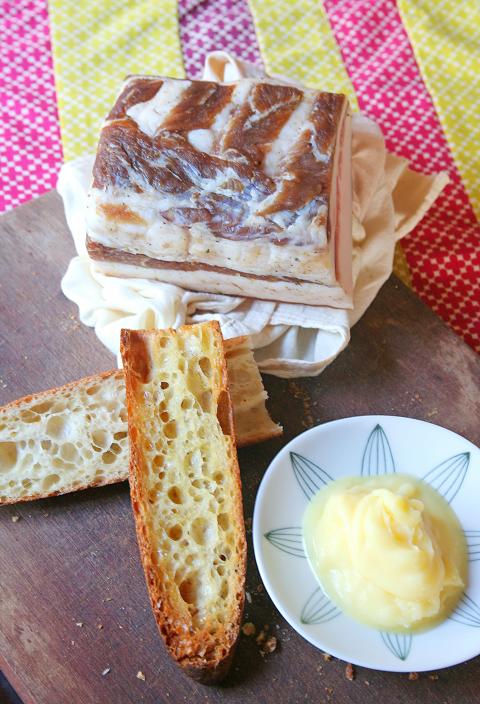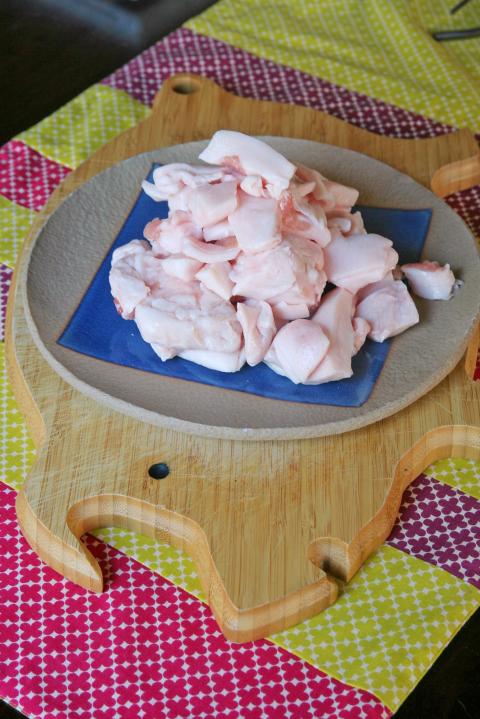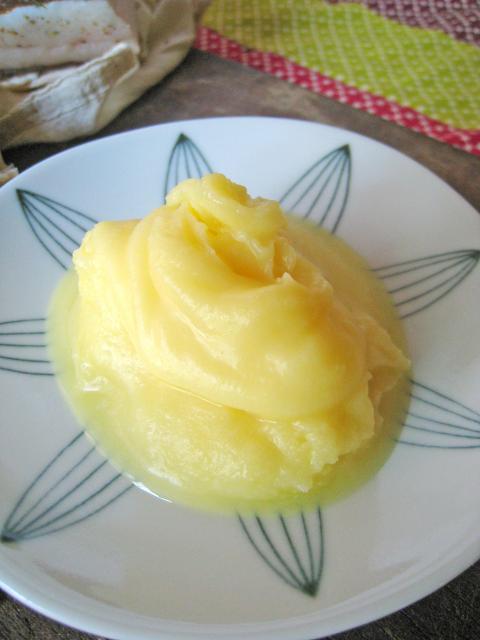The scandals surrounding various kinds of cooking oil and fats have raged in the media these last few months, making it almost impossible for the health conscious to know what can be eaten with assurance. The type of oil used is not something that is usually noticed by consumers when dining out, and food stalls and restaurants inevitably do what they can to reduce costs, often unknowingly using tainted or inferior oil (see Foul Taste on page 12 of Nov. 6 Taipei Times). Food manufacturers are ever eager to protect their bottom line and are not above passing on the health costs of substandard food to the consumer (see Cashing in On Adulterated Oil on page 12 of Nov. 25, 2013 Taipei Times). So what are we to do? Of course there are high-end imported oils readily available in the supermarket, but for the truly paranoid, nothing beats rendering oil yourself.
While vegetable oils are not something you can make at home, lard and schmaltz, the fat of pigs and chickens respectively, are relatively easy to manage, and really help to enhance flavor of all kinds of dishes from toasted sandwiches to elegant braised meats. It helps that animal fats have been enjoying a resurgence, with highly-regarded food writers and chefs touting their benefits, particularly now that hydrogenated fats — once marketed as the way to a slimmer, healthier body — have been shown to have been clogging our insides with trans-fatty acids and killing us slowly in all sorts of unnoticed ways. Books such as Australian chef Jennifer McLagan’s Fat: An Appreciation of a Misunderstood Ingredient and Michael Ruhlman’s The Book of Schmaltz: Love Song to a Forgotten Fat are just two excellent books that are making the case for the use of homemade animal fats and their many uses in the kitchen.
This is not the time or place for attempting to summarize the scientific arguments in favor and against the use of animal fats, but suffice to say that science is showing us what our ancestors knew all along: that animal fats are perfectly good for you when eaten in appropriate quantities. My own point of departure is simply that it tastes good, a realization I had as a child when I insisted on eating butter rather than margarine. I have gone on to discover that while butter remains one of life’s great pleasures, sandwiches toasted with chicken fat and potatoes fried in lard just cannot be beaten for flavor.

Photo: Ian Bartholomew
Pork back fat is readily available from traditional Taiwanese butchers, often already helpfully diced. In the past, it has always been cheap and easy to obtain, but I have noticed that more and more people are asking for this product at my local butcher, and it might be a good idea to put in an order in advance.
As for chicken fat, this is not so easy to obtain commercially. Its availability ties in with something I have wanted to write about for some time: the benefits of using a whole chicken. Getting our chickens from a local farmer, I feel it is necessary to find a use for every bit of the bird, not least the skin and fat, and now I find that schmaltz is something that I simply cannot do without in my larder. I would only recommend rendering chicken skin and fat if you are purchasing organic or naturally raised chicken, as factory-raised chickens probably contain high levels of antibiotics and other undesirable elements that will only get concentrated in the fat you render.
If you have an oven, rendering chicken and pork fat is a pretty straightforward affair. Though time consuming, it does not require much hands-on involvement and you just need to keep an eye on the time. Fat can also be rendered on the stove top, but requires more involvement in the form of regular stirring to prevent the fat from coloring too much. The whole process also involves some unpleasant washing up at the end, but if you do a large quantity, it is definitely a worthwhile investment of time and effort. The fat keeps well in the fridge for months and can be frozen for up to a year.

Photo: Ian Bartholomew
Rendered Fat
Start with about 1kg of pork back fat or a mix of chicken fat and skin. This should be very cold, or even partially frozen, making it much easier to handle. Chop into small pieces and lay out in a heavy flameproof casserole.
In the oven

Photo: Ian Bartholomew
1. Preheat the oven to about 120c.
2. Add around 75ml of water for every 500g of fat to prevent it coloring. This will evaporate during cooking.
3. Place the casserole in the oven. Stir at around 30 minutes, then stir every half hour until the fat just begins to color, around three to four hours. The smaller the pieces of fat, the more quickly it will render.
4. As soon as the fat begins to color, remove from the oven and allow to cool slightly. Pour the oil through a muslin cloth into clean containers. When cold, refrigerate.

Even by the standards of Ukraine’s International Legion, which comprises volunteers from over 55 countries, Han has an unusual backstory. Born in Taichung, he grew up in Costa Rica — then one of Taiwan’s diplomatic allies — where a relative worked for the embassy. After attending an American international high school in San Jose, Costa Rica’s capital, Han — who prefers to use only his given name for OPSEC (operations security) reasons — moved to the US in his teens. He attended Penn State University before returning to Taiwan to work in the semiconductor industry in Kaohsiung, where he

On May 2, Chinese Nationalist Party (KMT) Chairman Eric Chu (朱立倫), at a meeting in support of Taipei city councilors at party headquarters, compared President William Lai (賴清德) to Hitler. Chu claimed that unlike any other democracy worldwide in history, no other leader was rooting out opposing parties like Lai and the Democratic Progressive Party (DPP). That his statements are wildly inaccurate was not the point. It was a rallying cry, not a history lesson. This was intentional to provoke the international diplomatic community into a response, which was promptly provided. Both the German and Israeli offices issued statements on Facebook

May 18 to May 24 Pastor Yang Hsu’s (楊煦) congregation was shocked upon seeing the land he chose to build his orphanage. It was surrounded by mountains on three sides, and the only way to access it was to cross a river by foot. The soil was poor due to runoff, and large rocks strewn across the plot prevented much from growing. In addition, there was no running water or electricity. But it was all Yang could afford. He and his Indigenous Atayal wife Lin Feng-ying (林鳳英) had already been caring for 24 orphans in their home, and they were in

Australia’s ABC last week published a piece on the recall campaign. The article emphasized the divisions in Taiwanese society and blamed the recall for worsening them. It quotes a supporter of the Taiwan People’s Party (TPP) as saying “I’m 43 years old, born and raised here, and I’ve never seen the country this divided in my entire life.” Apparently, as an adult, she slept through the post-election violence in 2000 and 2004 by the Chinese Nationalist Party (KMT), the veiled coup threats by the military when Chen Shui-bian (陳水扁) became president, the 2006 Red Shirt protests against him ginned up by